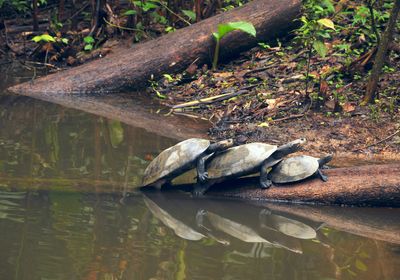ABOVE: Amazonian river turtles (Podocnemis expansa), one of the species included in the current study © ISTOCK.COM, XENI4KA
Turtles may never take top place among the animal kingdom’s most prolific vocalizers, but it turns out that they do indeed have something to say. In a new study published October 25 in Nature Communications, researchers found that turtles, along with other understudied animals, do in fact communicate using a diverse repertoire of vocal sounds. The study’s authors suggest that their finding may push the origins of acoustic communication back in time to the common ancestor of all lunged vertebrates.
Prior to the current study, many of the included species “were considered to be mute,” Gabriel Jorgewich-Cohen, a doctoral candidate at the University of Zurich, tells Scientific American. By listening carefully to recordings from 53 species—including turtles, lungfish, caecilians (a group of limbless amphibians), and New Zealand’s endemic, lizard-like tuatara—the team reached a different conclusion: that vocalization is more widespread than previously thought, and that “the sounds that turtles are making have the same evolutionary origin as our own vocal communication,” Jorgewich-Cohen says.
The paper’s findings add fresh fuel to debates around the abilities of some animals to communicate with one another. In 2020, two scientists published a paper in Nature Communications in which they mapped the evolutionary phylogenies of roughly 1,800 vocal and nonvocal species and postulated that acoustic communication had evolved independently in Earth’s major lineages (including frogs, birds, and mammals) in association with nocturnal lifestyles, New Scientist reports. In that analysis, turtles were lumped into the nonvocal group.
But evidence that seemingly nonvocal species do in fact use sound has been circulating outside of scientific circles for decades, if not generations. Irene Ballagh, a zoologist at the University of British Columbia who was not involved in the work, tells Scientific American that her mother recalled hearing tuatara communicate with one another despite “quite definitive statements” to the contrary by the scientific community.
Jorgewich-Cohen began to probe for sound in previously understudied species by studying his own pet turtles. “I decided to record them, just to check it out,” he tells New Scientist. “I found several sounds there, and then we just kept going [with more species]. And suddenly, I had good sampling and I could understand a bigger picture.”
From there, the team collected sounds from an additional 50 turtle species, as well as lungfish, tuatara, and caecilians. To better identify which scenarios might elicit sound, Jorgewich-Cohen traveled to five countries to record each species for at least 24 hours, and did so in various settings, including when the animals were alone or in same- or mixed-sex groups, and even when they were underwater. Every species the group studied produced at least one sound, and in many cases, these recordings were the first time such sounds had ever been heard.
While the study adds to scientists’ understanding of vocalizations in these groups, it also has implications for the evolution of auditory communications more broadly. When the researchers reanalyzed the earlier phylogenies with their data added in, they concluded that, rather than evolving multiple times, vocalization evolved once in a common ancestor. Specifically, Jorgewich-Cohen and colleagues traced vocalization back to the lobe-finned fish Eoactinistia foreyi, which is considered a possible last common ancestor of all choanate (lunged) vertebrates. That would mean that vocal communication evolved roughly 407 million years ago, at least 100 million years earlier than previously thought.
University of Western Australia biologist Gerald Kuchling, who was not involved in the study, tells New Scientist that he was “not surprised that all of them appear to vocalise,” echoing other experts’ point that many choanates have been omitted from previous studies. Speaking to Scientific American, Tecumseh Fitch, an evolutionary biologist at the University of Vienna who reviewed the new study but was not involved in the work, calls it “an important contribution, both because vocalizations from many important species are analyzed for the first time and because they lead to a convincing argument” that the behavior is indeed conserved across time.
Jorgewich-Cohen tells New Scientist that vocalization may be even older still, as lungless fish also produce sounds. “It could be that one lineage of those fishes was the precursor of the type of sound that we make as [choanates],” he says. “So it could be actually that this lineage of sound production is older than what I found.”
Speaking to Scientific American, John Wiens, an evolutionary biologist at the University of Arizona and a coauthor of the 2020 study, says that he doesn’t necessarily agree with the team’s findings. “A major focus of their paper seemed to be on reanalyzing our data and coming to a different conclusion,” rather than collecting evidence to demonstrate that the animals “are actually using those sounds to communicate with each other.” That, he adds, “seems like a big omission.”
Jorgewich-Cohen agrees that future studies will need to better establish the function of such sounds, Scientific American reports, and speaking to the outlet, Ballagh says that she hopes scientists will start to listen to and accept the knowledge of people living in close proximity to these creatures. “I would really love to see more people following up with more work connecting local and Indigenous sources of knowledge about the potential vocalizations for species groups that are still listed as an ‘absence of data’ in this paper,” Ballagh says. “I think the data might already be out there in some form if we just start to think more carefully about who we should be listening to.”







